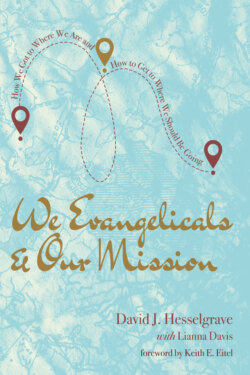Читать книгу We Evangelicals and Our Mission - Lianna Davis - Страница 7
На сайте Литреса книга снята с продажи.
Foreword
ОглавлениеOne former student returned from mission work in Jordan and presented me with a beautiful, hand-woven carpet depicting a scene of a train of camels in a caravan. Then he told me the story behind the carpet, which enhanced the meaning of the gift. An old man, ninety-five years old or so, was blind and wanted to teach his great-grandson the art of weaving such carpets. It took six months sitting closely behind his great-grandson, whispering in his ear thread by thread what to weave when and where to depict the beautiful scene upon completion. The old man could not see, but in his mind’s eye, he could see clearly because he had woven that pattern thousands of times and could recall every step from memory.
This imagery shows the concern of an elder generation for a younger one to relay a lifetime of knowledge and wisdom. It establishes the historical context, defines motion, and surfaces meaning to a process. We as evangelicals have witnessed the passing of an elder generation of missiologists. We are the grandchildren and great-grandchildren listening as one generation whispers into our ears theological and missiological wisdom, meaning, and purpose.
Such is the book in hand. David J. Hesselgrave became a dear friend as he mentored me through my doctoral work at the Trinity Evangelical Divinity School in the 1980s. I have highly valued his whispers ever since. He spoke with great learning, good historical understanding, and yet he did so with grace and humility. His words will ring true as you read. He wove together the threads of numerous theological traditions, and their impact on missions thinking, that have appeared over the last 500 years or so. That weave created a fine image of analysis and thoughtful critique that was always tethered to stable, inerrant truth from God himself and whispered into the ears of those eager to listen to things that are of eternal significance.
Four distinct patterns are outlined in this book. First, Hesselgrave sets evangelicals into the context of great traditions of thought, from the Reformation forward. Second, he demonstrates the trajectory of ecumenical thought as it intersected that of the evangelical traditions and altered them along the way. Third, controversial issues surface the ways evangelicals have wrestled with the intersection of ecumenical thought, and Hesslegrave cogently argued the issues with biblical conviction and reason. Finally, he points the reader to the significance of all these trends for the future of evangelicalism specifically and Christianity in general.
To demonstrate Hesselgrave’s keen sense of need to whisper in the ears of another generation, he invited his granddaughter, Lianna Davis, to write a concluding essay from the distinct point of view of a millennial. She carefully and transparently speaks of her own theological journey having lived life around her grandfather’s influence and her tussles of faith and understanding as she too studied in college and seminary. Her contribution shows she also sat weaving as the elder whispered into her ear the strands of thought from a wise grandfather.
Hesselgrave is gone now. Yet, his wisdom will sound loudly for at least another generation or two. To those of us touched by his weave of words, it will continually ring in our ears until we join him in eternity.
Keith E. Eitel
